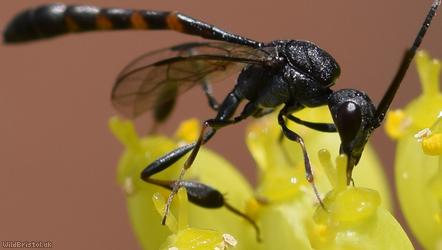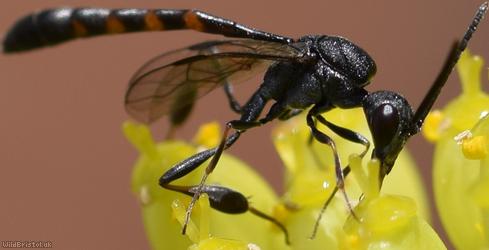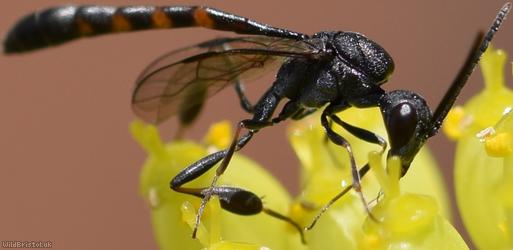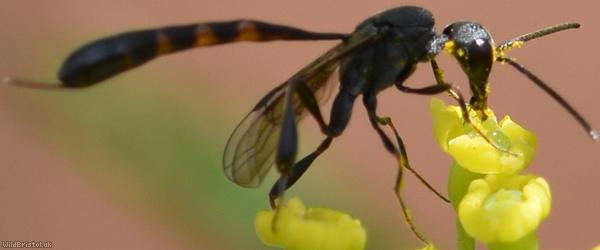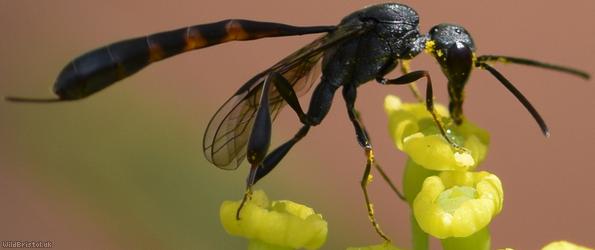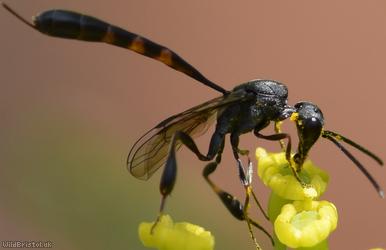Gasteruption minutum - Gasteruption minutum
Favourite Photos
Species Description
Widespread and sparse in the south (only 28 records according to NBN). It is no doubt under-recorded and probably a lot more frequent than records suggest. Habitat includes: Sunny locations with a good supply of hosts and Umbellifers such as gardens, parks, allotments, churchyards, wasteland, meadows, old quarries, woodland clearings etc. Life story: Females visit various solitary bee or wasp nests such as bee hotels, pushing her ovipositor into the nest, depositing her eggs on or near to the eggs of the host. When they hatch, they feed on the grubs of the host as well as the stored food (pollen). Gasteruption minutum is very similar to G. assectator but when viewed side on, the females ovipositor is shorter (about the same length as the last two tergites) and slightly curved at the base and the red marking on tergite 2 extends along the base and are often subtly present on tergite 5 as well). A lot of images on the internet appear to be wrongly identified for one or the other.
Useful Links:
Workings out:
- Gasteruption assectator (similar to G. minutum but the females ovipositor is straight and about as long as the last 3 tergites and red markings are present at the ends of tergite 2, 3 and 4 only)
- Gasteruption caucasicum (very similar to G. jaculator but no records in Britain according to NBN)
- Gasteruption erythrostomum (females ovipositor is long - about the same length as the abdomen excluding tergite 1)
- Gasteruption jaculator (the best known species by the females ridiculously long ovipositor)
- Gasteruption laticeps (females ovipositor is long. No records in Britain according to NBN)
- Gasteruption minutum (similar to G. assectator but the females ovipositor is shorter (about the same length as the last two tergites) and slightly curved at the base and the red markings are often subtly present on tergite 5 as well)
See ZooKeys for key.
-
Head in anterior view protruding below lower level of eyes 0.5 - 0.6 x length of second antennal segment and 0.4 - 0.6 x basal width of mandible and mandibular condylus distinctly below lower level of eyes (a); in lateral view condylar incision of malar space remains far removed from eye (b); ovipositor sheath 0.4 - 0.9 x as long as hind tibia (c); first discal cell of fore wing usually directly narrowed (d).......G. minutum
-
Head in anterior view slightly protruding below lower level of eyes by less than basal width of mandible and mandibular condylus near lower level of eyes (aa); in lateral view condylar incision of malar space close to eye (bb); ovipositor sheath 0.8 - 1.3 x as long as hind tibia (cc); first discal cell of fore wing usually gradually narrowed (dd).......
-
Mandible dark brown or reddish brown basally (a), rarely brownish yellow; basal depression of mandible rather large and deep (b); fifth (= pre-apical) sternite dark brown or blackish or narrowly pale medio-apically (c); [mandible slightly less convex; mesosoma black; hind basitarsus usually rather slender].......G. assectator
